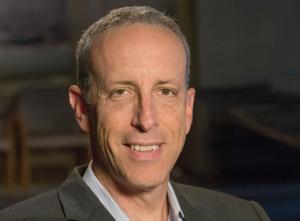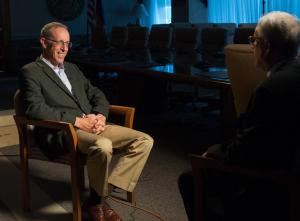CFO & Chief Strategy Officer
PUF's Steve Mitnick: You're the strategist for the New York Power Authority. What does that mean? Why is it important?

Robert Lurie: Our number one role is to keep the lights on and make sure that our plants are operating safely and reliably. But we also have a key role, in helping our customers achieve whatever their definition of success is. That's really been changing rapidly over time.
There have been a lot of changes in technology that have given us opportunities for us to add value to our customers. What we've been trying to do is to imagine, along with our workforce, how that future might play out.
Over the next several years we will bring together our workforce to talk about what scenarios could happen in terms of a continued evolution of technology. In terms of continuing the changes in how our customers use energy. And in how our business environment might change, regulation might change, the political environment might change, the economy might change.
We say, "Given all of those changes, and the opportunities they create as well as the risk they create, what should we be doing to make sure we're on the forward edge of using all of those technological and other changes to benefit our customers?"
 Robert Lurie: With large scale renewable energy, we’re going to be making some major investments, but also investing in distributed renewables.
Robert Lurie: With large scale renewable energy, we’re going to be making some major investments, but also investing in distributed renewables.
PUF's Steve Mitnick: You need to have a strategy that's robust, right?
Robert Lurie: When we look at all these scenarios we say, "What could we be doing that would be robust in each of those scenarios?" We try to play out how our model, how various strategies might work given different states of the world that we might imagine in the future.
The strategies that are robust in as many scenarios as possible are ones that are the most valuable. We have really accelerated our strategy in certain areas. Back in 2014 we came up with our six initial strategies and those continue to be viable and strong. We're tweaking those and re-emphasizing certain areas and taking advantage of some of the technological changes.
PUF's Steve Mitnick: What would be an example of a tweak?
Robert Lurie: There are a couple of things I would point to. One is the tremendous drop in the cost of new energy technologies. Like for renewable energies, solar for example, price drops have been far more than what were predicted back in 2014.
That provides tremendous opportunities for our customers to use solar, not just to be green, but also to save money. We are really expanding our emphasis on renewable energy.
With large scale renewable energy, we're going to be making some major investments, but also investing in distributed renewables, to take advantage of the cost drops. The other area that we've really emphasized is the tremendous expansion of the use of big data and data analytics.
All the artificial intelligence technology lets us digitize our business from end to end.
And to use all those new digital technologies to help our employees provide even better service to our customers.
It doesn't replace our employees, as some maybe fear that artificial intelligence will do. Rather, it gives our employees tools to provide greater and greater insight into our customer needs. And insight into how we can run our plants better, to keep our costs down and make our plants even more reliable.
PUF's Steve Mitnick: Things will keep changing, so maybe you'll have to do a strategic refresh every six months, and then every two months.
Robert Lurie: There certainly is reason to believe that these technological changes will accelerate, and continue to accelerate, and then we will have to make sure that we are revising our strategic plan on an as-needed basis.
We're building processes into our strategic planning to make sure that we're re-assessing the plan constantly for changes in the business environment and in technology.
Then we're not missing out on new opportunities to create value for customers.
PUF's Steve Mitnick: Who do you collaborate with? Who sits in these meetings and what do they do?
Robert Lurie: We try to bring people from across our business and at various levels, to make sure we have representation of all different kinds of skills and viewpoints when we have these meetings.
It's not just the people on the senior executive team that are having these conversations. We bring people from our operating plants, and we bring people from our various support services. We make sure we have experts in technology, and people who also help us think about the future.
That's what our strategic planning team does, is try to facilitate these viewpoints to come together in thinking about the future. We encourage people to take the blinders off and get themselves out of the conversations about the problems that they are dealing with every day to keep the plants running. To think about what might happen in the future.
Look outside of NYPA and think about our customers, and how our customer needs might be changing in the future.
That's really the role we play.
PUF's Steve Mitnick: How did you get to this point in your career?
Robert Lurie: I spent the first half of my career both in public finance and corporate finance. I started as an investment banker. In the second half of my career I went into strategy, corporate strategy, public sector strategy, mergers and acquisitions, and project development and renewable energy.
Now I'm doing both of those things. I brought both halves of my career together and that's been really enjoyable. Our CEO, Gil Quiniones, has given me a lot of responsibility, which I enjoy.
It's fun every day. I particularly like bringing a lot of young people into our business, finding ways to use their knowledge and their enthusiasm to help create the new energy industry that we're trying to bring about.
PUF's Steve Mitnick: Is NYPA going to be different five years from now?
Robert Lurie: There are some very tangible ways that it's going to be different, and then some less tangible ways. In tangible ways, we're going to be investing in large scale renewable energies, so our asset base is going to be different.
We hope to be financiers and possibly owners of renewable energy, along with our customers, to help them to become more sustainable and lower their costs. Our asset base might be somewhat different.
We hope to invest in storage and electric vehicle infrastructure as well, that's the tangible side of the changes. From the less tangible standpoint, we really want to be leaders in pointing the way to the new energy industry. We believe strongly that it is going to be much more digitized, and much more based on data analytics.
We hope to be using a lot of these new technologies real-time, in terms of decision making.
Instead of the old way we have done things in the past, where you have operators making decisions.
We're going to be able to use these technologies to make the system much more flexible to respond to the needs of the system in real time. We're going to need to have a culture that's much more flexible too.
We hope to be viewed as a leader in creating these new technologies, promoting the use of them in the system, and creating the new culture that will bring this about. It will be a lot more flexible and responsive.
2020 Strategic Refresh:
- Gil Quiniones, CEO, New York Power Authority
- Robert Lurie, CFO & Chief Strategy Officer
- Emilie Bolduc, VP, New York Energy Manager
- Ricardo DaSilva, VP, Strategic Operations
- Doug McMahon, VP, Strategy



